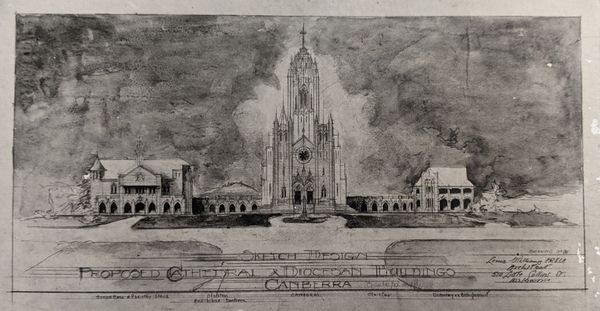“Something Splendidly Appealing”
By Mrs Annette Carter, College Historian
During his time as Bishop of Goulburn, Radford pushed for support for a cathedral and national Anglican presence in Canberra. He had assistance from people such as the Attorney-General, Sir Littleton Groom, who echoed Radford’s vision for Canberra in a letter dated 1923:
“It seems to me that when Australia has its own seat of government in its own territory, there should be a Bishop of the Church for the territory. There will be much parish work to be done in a city that within ten years of its establishment will, according to the statisticians, have a population of about 15,000 people”[i].
In 1910, Synod had appointed a committee to secure a site for an Anglican cathedral in Canberra. It eventually obtained a five-acre site near Parliament House on Rottenbury Hill (now St Mark’s Theological College). The architect Louis R. Williams was sent to survey the site’s suitability. He observed, in 1925, that it was in a good position with views to Capitol Hill, St John’s Church, Mt. Ainslie and the Molongolo Valley, “where the proposed East Lake will be created,” and the hills of Duntroon[ii].
Provisional sketch plans from Williams were included with the report to show the scale and scope of the buildings with a note: “Visualise for a moment the setting. Would there not be a chance for something splendidly appealing?”
The land had been secured, and now thoughts turned to building the cathedral. In 1927, there was a radical proposal to dismantle and transfer St Andrew’s Anglican Cathedral from Sydney to Canberra, but it was decided it would be “inadvisable to attempt its removal”[iii].

Instead, an architectural competition was held.
Harold Crone won the competition (receiving £300, with £200 going to second place, and £100 to third). His Romanesque cathedral complex, which also included a Chapter House, Synod Hall and Deanery, would cost “£150,000, not including the interior decorations.”[iv]


Radford then set out on a campaign to raise the funds for the cathedral. The site was dedicated in 1927 with the erection of a wooden cross (which was subsequently burnt down by vandals in 1937). After the service, forms were handed out for the promise of donations and collections were taken. A fundraising poster was also printed:

Finances, along with administration difficulties, would eventually put an end to Bishop Radford’s cathedral plans.
His own son, Paul Radford, observed that, “each person has his own gifts as St. Paul reminds us of and of the many gifts that LBR [Lewis Bostock Radford] possessed, the collecting and handling of money was not amongst them”[v]. It was initially agreed that a bank overdraft of £250 would be drawn to cover competition expenses[vi]. To pay that money back, it was recommended that Anglican dioceses should contribute to the Cathedral fund, but there was no binding obligation for them to do so. This resulted in a large deficit which, in 1937, was only just paid off by voluntary assessment of some dioceses.
There was also a struggle to get the Australian Church to accept responsibility for this work[vii]. Groom, by this time Speaker of the House, wrote to Radford in 1926 to express that the “obligation to build that structure is Australian”[viii]. It was a view that Radford struggled to get Synod to agree on.
As Paul Radford observes: “Perhaps he pushed his views, and the views of his Committee, too often, too forcibly and perhaps too brusquely. He was never one to suffer fools gladly, and what to him was stupid opposition he found hard to stomach”[ix].
In 1930, there were “lengthy, acrimonious and painful” discussions at Synod and the plans for the cathedral, and the formation of a new diocese to administer it, were deemed “inopportune at the present moment”[x]. In the end, when Bishop Radford died seven years later, his ashes were interred underneath St John’s Church, Reid, waiting for the national cathedral to be built.
[i] Littleton Groom, (1923, Apr 2). [Memo to Bishop Radford]. Papers belonging to Lewis Bostock Radford. St Mark’s Theological College Library, Canberra. [ii] Littleton Groom (1925, Nov 26). [Letter to Bishop Radford]. Papers belonging to Lewis Bostock Radford. St Mark’s Theological College Library, Canberra.
[iii] “St Andrew’s Cathedral”. The Argus, 20 Dec 1927, p. 3. [iv] Paul Radford. A Scholar in a New Land: Lewis Bostock Radford. Flinders University, 1979. p. 85.
[v] Radford. p. 86. [vi] Lewis Radford (1928, Apr 17). [Letter to Littleton Groom]. Canberra Cathedral. St Mark’s Theological College Library, Canberra.
[vii] “A goodly heritage: a history of the Diocese of Canberra and Goulburn: Lewis Bostock Radford, fourth Bishop of Goulburn, 1915-1933.” Southern Churchman, v.60, September 1962. p. 5. [viii] Littleton Groom (1925, Feb 11). [Letter to Bishop Radford]. Papers belonging to Lewis Bostock Radford. St Mark’s Theological College Library, Canberra.
[ix] Radford. p. 77. [x] Radford. p. 87-88.
